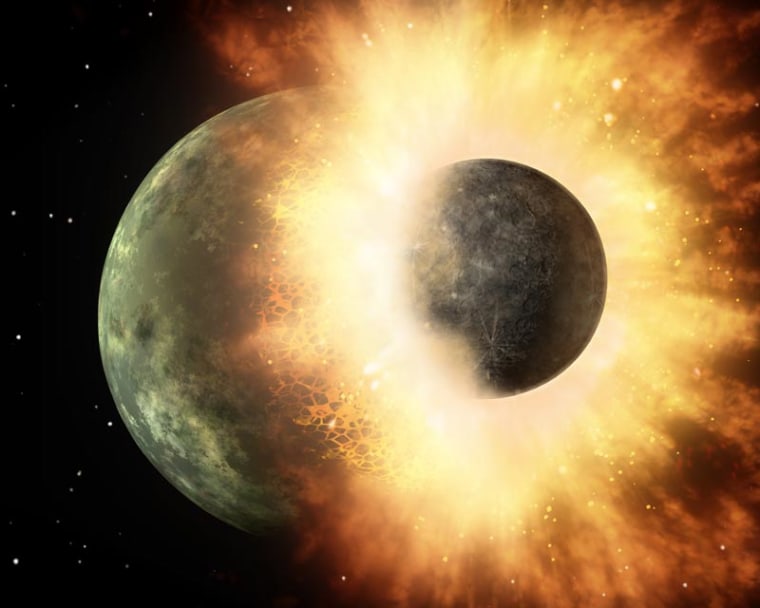Two distant planets orbiting a young star apparently smashed into each other at high speeds thousands of years ago in cosmic pileup of cataclysmic proportions, astronomers announced Monday.
Telltale plumes of vaporized rock and lava leftover from the collision revealed its existence to NASA's Spitzer Space Telescope, which picked up signatures from the impact in recent observations.
The two-planet pileup occurred within the last few thousand years or so — a relatively recent cosmic timeframe. The smaller of the two bodies — a planet about the size of Earth's moon, according to computer models — was apparently destroyed by the crash. The other was most likely a Mercury-sized-planet and survived, albeit severely dented.
"This collision had to be huge and incredibly high-speed for rock to have been vaporized and melted," said Carey Lisse of the Johns Hopkins University Applied Physics Laboratory in Maryland, lead author of a paper describing the findings in the Aug. 20 issue of the Astrophysical Journal.
Researchers believe the planets were moving at about 22,400 mph (10 kilometers per second) before the crash. The violent wreck released amorphous silica rock, or melted glass, and hardened chunks of lava called tektites. Spitzer also spotted large clouds of orbiting silicon monoxide gas created when the rock was vaporized.
"This is a really rare and short-lived event, critical in the formation of Earth-like planets and moons," Lisse said. "We're lucky to have witnessed one not long after it happened."
Infrared detectors on Spitzer found the traces of rocky rubble and re-frozen lava around a young star, called HD 172555, still in the early stages of planet formation. The system is about 100 light-years from Earth. One light-year is the distance light travels in a year six trillion miles (9.7 trillion km).
A similar fender-bender is thought to have formed Earth's moon more than 4 billion years ago, when a body the size of Mars rammed into Earth.
"The collision that formed our moon would have been tremendous, enough to melt the surface of Earth," said co-author Geoff Bryden of NASA's Jet Propulsion Laboratory in California. "Debris from the collision most likely settled into a disk around Earth that eventually coalesced to make the moon. This is about the same scale of impact we're seeing with Spitzer — we don't know if a moon will form or not, but we know a large rocky body's surface was red hot, warped and melted."
In fact, such violent encounters seem to have been common in our own solar system's early history. For example, giant impacts are thought to have stripped Mercury of its outer crust, tipped Uranus on its side and spun Venus backward.
As recently as last month, a small space rock slammed into Jupiter, making a large black bruise.
In general, rocky planets like Earth coalesce and grow when small rocks crash and clump together, merging their cores.
The system around HD 172555 is a relative baby at only 12 million years old, compared to our solar system's age of 4.5 billion years.
